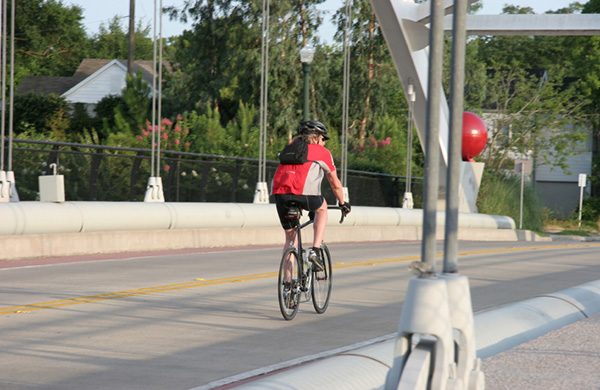GROUPON GUIDE TO HOUSTON
Biking Houston
BY: Gayot |Feb 7, 2014
BY:
Deals in Houston

Kids Dance Classes with Drop-in and Mega Pass Options
1824 Spring Street, Houston • 1.2 mi
$31.50$28.35
Sale Ends 12/28
The Artz

Trending
Cinematic Magic Begins with Regal Premiere & Premium Format Tickets
3839 Weslayan Street, Houston • 5.2 mi
12% discount_off
Regal

Splash into Fun: Day Tickets & Season Passes at Pirates Bay Water Park
5300 East Road, Baytown • 23.8 mi
Sale Ends 12/28
Pirates Bay Water Park
Deals in Houston Other Deals in Houston

Trending
Offer Extended! Score 50% Off an Arcade Game Card at AMF & Bowlero
19102 West Montgomery Road, Houston • 11.5 mi
Sale Ends 12/28
AMF – Bowlero – Bowlmor

Trending
Up to 37% Off on Museum at Houston Toy Museum
321 West 19th Street, Suite C, Houston • 3.6 mi
Sale Ends 12/28
Houston Toy Museum

31% Off Jump Passes, Bowling, or Party at Launch - West Houston
13331 Westheimer Road, Houston • 15.9 mi
15% discount_off
3 bought
Launch Family Entertainment - West Houston
 At about 600 square miles, with chronic heat and humidity for most of the year, it’s no wonder that Houston is a car-centric town. But in recent years the city has undergone a bike-riding transformation, particularly inside the loop.
Houston has more than 300 miles of interconnected bikeways that include bike lanes on city streets, hike and bike trails along the bayous, and throughout many city parks. The local nonprofit organization BikeHouston holds a yearly moonlight ride, and the Greater Houston Off-Road Biking Association likes to get in on the fun with events of their own. There’s also Critical Mass, a loose-knit group of cyclists who meet downtown on the last Friday of every month for a massive ride through the streets. The extremely popular event can attract 2,000 riders or more, although such cycling enthusiasm is not always to the benefit of automobile drivers in their path.
Beyond organized rides and city trails, more and more Houstonians are using bikes to get around town on a daily basis. The city passed an ordinance requiring car drivers to give riders on two wheels more than three feet of space on roads without dedicated cycling lanes, and is building more bicycle-friendly pathways throughout the area.
Don’t have a cool ride to call your own? No problem. Last year, Houston B-cycle launched a bike sharing program downtown where residents and visitors alike can borrow bright red bikes for 60 minutes, with a 24-hour, weekly or annual membership that can be purchased online or at the bike stations. The B-cycle campaign started with three stations and 22 bikes, but has expanded to more than twenty stations with some 300 bicycles, with more growth in sight. There are now stations downtown, along the East End, in the Museum District and at certain stops on the city’s METRORail line. Bicycles can be borrowed and returned at any B-cycle station and paid for with a credit card, which makes for convenient riding for anyone visiting the city.
Just remember that in Houston, cyclists are subject to the same rules as cars. That means no riding on business-district sidewalks, having to stop at traffic signals and – if you’re under eighteen – riding with a helmet on.
At about 600 square miles, with chronic heat and humidity for most of the year, it’s no wonder that Houston is a car-centric town. But in recent years the city has undergone a bike-riding transformation, particularly inside the loop.
Houston has more than 300 miles of interconnected bikeways that include bike lanes on city streets, hike and bike trails along the bayous, and throughout many city parks. The local nonprofit organization BikeHouston holds a yearly moonlight ride, and the Greater Houston Off-Road Biking Association likes to get in on the fun with events of their own. There’s also Critical Mass, a loose-knit group of cyclists who meet downtown on the last Friday of every month for a massive ride through the streets. The extremely popular event can attract 2,000 riders or more, although such cycling enthusiasm is not always to the benefit of automobile drivers in their path.
Beyond organized rides and city trails, more and more Houstonians are using bikes to get around town on a daily basis. The city passed an ordinance requiring car drivers to give riders on two wheels more than three feet of space on roads without dedicated cycling lanes, and is building more bicycle-friendly pathways throughout the area.
Don’t have a cool ride to call your own? No problem. Last year, Houston B-cycle launched a bike sharing program downtown where residents and visitors alike can borrow bright red bikes for 60 minutes, with a 24-hour, weekly or annual membership that can be purchased online or at the bike stations. The B-cycle campaign started with three stations and 22 bikes, but has expanded to more than twenty stations with some 300 bicycles, with more growth in sight. There are now stations downtown, along the East End, in the Museum District and at certain stops on the city’s METRORail line. Bicycles can be borrowed and returned at any B-cycle station and paid for with a credit card, which makes for convenient riding for anyone visiting the city.
Just remember that in Houston, cyclists are subject to the same rules as cars. That means no riding on business-district sidewalks, having to stop at traffic signals and – if you’re under eighteen – riding with a helmet on.